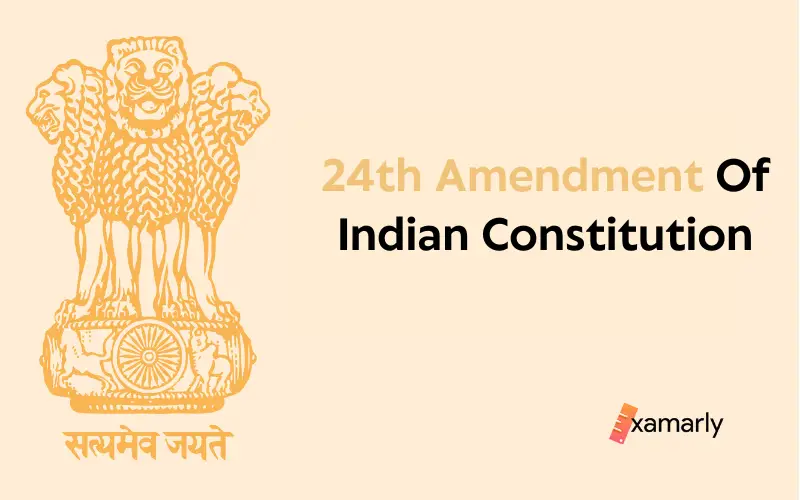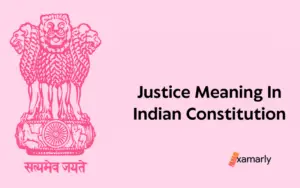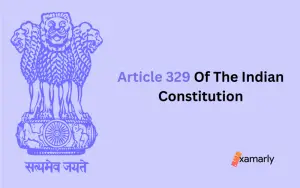The 24th Amendment of Indian constitution holds a unique place in the history of Indian law.
In order to overturn the Supreme Court’s decision in Golaknath v. State of Punjab, the 24th Amendment of Indian Constitution was implemented. The verdict overturned the Supreme Court’s prior ruling, which had affirmed Parliament’s authority to amend the Constitution. After the ruling, Parliament lacked the authority to limit fundamental rights. The government sought to change article 368 to explicitly state that Parliament has the authority to amend any provision of the Constitution in order to overturn the judgment. This would include Fundamental Rights as part of the Constitution’s amending process.
With many controversies in past, this amendment is a pivotal part of the UPSC exam and other State PCS. This article discussed some previous judgments, consequences, importance, and reference to the Kesavananda Bharati case in detail, for better insight.
- 24th Amendment Of Indian Constitution: Background
- Sajjan Singh vs. State Of Rajasthan Case 1964
- I.C. Golaknath vs State Of Punjab, 1967
- Consequences Of The Verdicts
- Objects And Reasons
- Provisions Incorporated By 24th CAA
- Significance
- Kesavananda Bharati v. State Of Kerala Case In reference To Constitutional Validity
- Consequences Of This Provision
- Conclusion
- FAQs
24th Amendment Of Indian Constitution: Background
Before knowing this amendment in detail, we should take a glance at the legal history of some previous decisions by the Apex Court, which paved the way for this Twenty-Fourth Amendment:
Sajjan Singh vs. State Of Rajasthan Case 1964
In 1964, a Constitutional Amendment (17th Amendment Act) has been passed in order to Prohibit the acquisition of land under personal cultivation unless the market value of the land is paid as compensation. This amendment has also incorporated 44 more acts in the controversial Ninth Schedule, which is act as a shield for some provisions from judicial review. Sajjan Singh cited this amendment as a violation of his Constitutional Rights and hence filed a petition in the Apex Court.
One such issue that the Supreme Court had to address was whether or not the Seventeenth Amendment Act of 1964, which was approved by parliament in accordance with its authority under article 368 and amended article 31A of part III of the Constitution, was constitutional. In his judgment, SC stated that Article 368 of the Indian Constitution empowers the Parliament to amend any article of the Constitution. According to the majority decision, it was held that Parliament has the power to amend the fundamental freedoms of the people.
However, this decision of the SC was overruled in the Golaknath Case.
I.C. Golaknath vs State Of Punjab, 1967
The Supreme Court of India decided the landmark case of I. C. Golaknath v. State Of Punjab 1967. By a narrow majority of vote 6-5, the Court ruled on February 27, 1967, that an amendment to the Constitution is invalid if it “deprives or curtails” a fundamental right guaranteed by Part III and that an amendment made in accordance with article 368 is “legal” under the terms of article 13 of the Constitution.
In this case, Supreme Court acknowledges that Fundamental rights cannot be diluted, abridged, diminished, finish, or taken away and then in response to it by bringing an amendment to the Constitution and inserting Article 31 (C) in part III. The well-known Golak Nath case is often cited as a landmark case in Indian history. It limits the arbitrary power of parliament and protects the fundamental features of the constitution.
Consequences Of The Verdicts
The Golak Nath judgment has driven a power struggle between the legislature and judiciary. Judiciary has put a limit on parliament’s power to amend the constitution, due to this ruling party couldn’t perform some promises they had made to the public during elections. This resulted in the loss of significant support in some states. The power tussle with the judiciary has forced the legislature to bring some crucial series of measures to uphold parliamentary authority, like the nationalization of banks and abolition of Privy Purses.
The 24th amendment act was one of the several amendments that were introduced in 1971 and 1972 to establish parliament’s authority over the Constitution and Judiciary.
Objects And Reasons
In the Controversial Golak Nath case, the Apex Court narrowly overturned its own earlier rulings affirming Parliament’s right to change all provisions of the Constitution, including Part III, which deals with basic rights. This judgment curtails Parliament’s authority to remove or limit any of the fundamental rights, even if doing so becomes necessary for carrying out the Directive Principles of State Policy and achieving the goals outlined in the Preamble to the Constitution. Because of this, it became necessary to define Parliament’s authority to alter any article of the Constitution in order to bring the provisions of Part III into the purview of that amending power.
The Bill clearly states that article 368 provides for amendment of the Constitution as well as the method accordingly. The Bill also mentioned that the President must provide his consent when a Constitution Amendment Bill that has been approved by both Houses of Parliament is brought to him for approval. The Bill also aims to change Article 13 of the Constitution such that it no longer applies to any amendments made in accordance with Article 368.
Provisions Incorporated By 24th CAA
Some special provisions of this amendment are the detailed following:
- In Article 368, a reassuring section (3) was added, that states that “nothing in Article 13 shall apply to any change made under this Article.”
- This constitution amendment has also changed the full text of article 368 from Procedure for Amendment of article of the Constitution to Power of Parliament to amend the Constitution and procedure.
- It made President’s assent compulsory for any amendments.
Significance
The assembly led by Indira Gandhi saw the need to craft the constitution’s provisions such that the DPSP described in Part IV of the document had been firmly enacted throughout the nation. So it needs to construe some provisions of the constitution in such a way that they work harmoniously without harming the basic rights of citizens. For upholding the Directive Principles of State Policy and achieving the objectives set forth in the Preamble to the Constitution, parliament requires the absolute power of amendment.
Kesavananda Bharati v. State Of Kerala Case In reference To Constitutional Validity
In the Kesavananda Bharti case, the Supreme court reviewed its own judgment of the Golak Nath case. This case has challenged the constitutional validity of two Kerala Land Reforms Acts and the validity of the 24th, 25th, 26th, and 29th Amendments. It emphasized the separation of powers and the supremacy of the Constitution.
The case was heard before the 13-judge who made up the largest-ever Constitutional Bench. The Court decided in line with the notion that Parliament has the authority to change fundamental rights by upholding the constitutionality of clause 1 of article 13 and a related provision in article 368(3), which was added by the 24th Amendment of Indian Constitution. It also upheld the constitutionality of sections 2(a) and 2(b) and the first part of section 3 of the 25th Amendment. However, it was ruled that the second part was unconstitutional.
However, in 1976, The Kesavananda Bharati decision was overturned by the government by passing the 42nd Amendment.
Further Reading:
- 25th Amendment Of Indian Constitution
- 29th Amendment Of Indian Constitution
- 42nd Amendment Of Indian Constitution
- 26th Amendment Of Indian Constitution
Consequences Of This Provision
In 1971, the Prime Minister of India, Indira Gandhi, passed the 24th Amendment. It was part of her attempts to consolidate authority and a one-party rule. In the years following the 24th Amendment, the legislature passed four other constitutional amendments, whose purpose was to weaken the judiciary and increase the power of the Prime Minister. These were the most controversial amendments in the history of the Indian Constitution.
Conclusion
The 24th Amendment to the Indian Constitution has been debated ever since its introduction. The government has argued that the 24th amendment will help to implement the Directive Principles of State Policy. However, a large section of constitutional experts would believe that the undisputed authority of Parliament is a threat to the democratic process in the country. In Indian Constitution, the balance of legislative power is vital, and the power of amendment conferred to parliament to alter such regulations is often considered an important one.
However, the Supreme Court has ruled that the 24th Amendment Act is Constitutional. The ruling has several important implications. While it confirms that the 24th Amendment Act is valid, it establishes some significant constituent features like Judicial review and basic features of the Constitution.
FAQs
Q1. When Was 24th Amendment Added To Indian Constitution?
The 24th Amendment of Indian constitution was enacted on 5 November 1971.
Q2. Who Introduced The Bill Of The 24th Amendment?
The 24th amendment was brought by then Minister of Law & Justice, H.R. Gokhle in response to the previous ruling of the Supreme Court in Golaknath v. State of Punjab.
Q3. Why 24th Amendment Enacted?
The 24th Amendment of Indian Constitution came in response to judgement of the Supreme Court in Golak Nath vs the State of Punjab, which restricts the legislative to amending some provisions of the constitution. This amendment enables Parliament the authority to change any part of the Constitution including Fundamental Rights.






